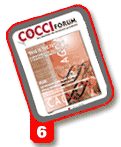COCCI FAQs
Schering-Plough Animal Health's technical service team answers questions about managing coccidiosis
Q.COCCIDIOSIS VACCINES FOR POULTRY HAVE BEEN AROUND SINCE THE 1950S. WHY ARE WE HEARING ABOUT THEM MORE NOW?
A. Several reasons. In a nutshell:
Traditional, in-feed anticoccidials such
as salinomycin and other ionophores
have been so widely used that resistance
to them is developing, resulting in
coccidiosis outbreaks. Furthermore,
consumer demand has increased for
birds raised with fewer drugs in the
food chain. Immunization offers a more
natural approach for control of coccidiosis
in poultry. In recent years, new
methods of administering coccidiosis
vaccination have been developed to
ensure better uniformity and efficacy
than in the past.
Q. DOES IMMUNITY INDUCED BY
COCCIDIOSIS VACCINATION AGAINST
ONE COCCIDIAL SPECIES PROVIDE
CROSS-PROTECTION AGAINST OTHER
COCCIDIAL SPECIES?
A. No. Immunity against one particular
coccidial species is specific and will
not protect against another coccidial
species. Consequently, vaccines each
contain several species of coccidia
known to be a problem in the targeted
bird population. That's how broad protection
against coccidiosis is achieved
with vaccines.
Q. WON'T BIRDS DEVELOP IMMUNITY
TO COCCIDIA ON THEIR OWN, WITHOUT
VACCINATION?
A. It's possible if birds are accidentally
exposed to infective oocysts. But
the development of immunity also
depends on how often and how long
birds are exposed and they may not be
exposed to all the various species of
coccidia that could pose a problem
down the road. The development of
natural immunity also may not be realized
until at least 6 weeks of age.
In other words, the development of
adequate natural immunity soon
enough to meet the needs of poultry
producers cannot be guaranteed. That's
why the acquisition of immunity
through controlled exposure by vaccination
is preferable.
Q. CAN RESISTANCE TO COCCIDIAL
ORGANISMS DEVELOP WHEN VACCINATIONS
ARE USED TO MANAGE COCCIDIOSIS?
A. No. Vaccination enables birds to
naturally develop lifelong immunity
against coccidia, which helps prevent
the development of coccidiosis. No
resistance develops. In contrast, in-feed
anticoccidials control the development
of coccidiosis by minimizing the existing
population of coccidia. This is an
entirely different approach to coccidiosis
control that can and has resulted in
the development of resistance to anticoccidials,
particularly those used over
a long period of time.
Q. CAN COCCIDIOSIS VACCINATION
HELP RESTORE EIMERIA SENSITIVITY TO
SALINOMYCIN AND OTHER
IONOPHORES?
A. It can, as long as the vaccine used
provides live, drug-sensitive coccidia.
Research conducted by Dr. Harry D.
Danforth, PhD, a USDA research
microbiologist, has demonstrated that
vaccinating with Coccivac-B "a product
containing live, drug-sensitive coccidia
"changes the sensitivity of coccidia
on the floor of grow-out houses.
More specifically, studies by Danforth
showed that using this type of vaccine
helped restore sensitivity to the ionophore
salinomycin.
When live coccidial oocysts are
delivered with the vaccine, they replicate
and replace drug-resistant field
strains. The coccidial population in the
house shifts to the more sensitive
strains. Because most ionophores work
the same in inhibiting coccidia, it can
be extrapolated that sensitivity should
be restored for other ionophores as
well. Vaccination with coccidia that are
not sensitive to drugs or that are salinomycin
resistant would not restore
sensitivity.
Danforth's work also shows that
after vaccination with a live-oocyst vaccine,
an aggressive Eimeria tenella
strain disappeared altogether and that
lesions due to other species of Eimeria
were minimized.
Q. COULD VACCINATION INTRODUCE
MYCOPLASMA OR OTHER DISEASES TO
BIRDS?
A. Not if it's a high-quality product
made by a reputable manufacturer.
Coccivac-B, for example, is produced
according to strict quality-control
methods and undergoes multiple tests
to ensure purity. Schering-Plough
Animal Health tests the product during
several stages of production to make
sure that final batches are free of bacteria,
fungi and mycoplasma, even
though mycoplasma testing for coccidiosis
vaccines is not required by the
USDA.
Special extra testing also is conducted
when indicated. A few years ago,
poultry producers were concerned
about a new avian leucosis virus subgroup
known as J virus. A study initiated
in collaboration with the University
of Delaware demonstrated that production
procedures for producing Coccivac
vaccines would eliminate J virus if it
were present. Another similar study
conducted later showed that Coccivac
vaccine production also would eliminate
chick anemia virus.
Q. A FEW DAYS AFTER BIRDS ARE
VACCINATED FOR COCCIDIOSIS, SOME
ARE STILL STAINED FROM THE DYE USED
IN THE VACCINE TO CHECK FOR UNIFORM
COVERAGE. DOES THE PRESENCE
OF THE DYE MEAN THAT SOME
OOCYSTS FROM THE PRODUCT HAVE
NOT BEEN INGESTED?
A. Chicks are attracted to reds and
other primary colors, so the red dye in
a coccidiosis vaccine actually encourages
preening by chicks in the hatchery.
The ingestion of oocysts occurs
immediately following vaccination. The
lingering presence of the dye indicates
that the birds have in fact been properly
vaccinated, but does not mean that
any vaccine has gone unused.
Have more questions about coccidiosis vaccination? Send yours to the editor at
[email protected] or by fax to 928-569-2491. You'll get a personal reply from a Schering-
Plough Animal Health Corporation technical service representative and we may include it
in our next issue of CocciForum.
Source: CocciForum Issue No.6, Schering-Plough Animal Health.







